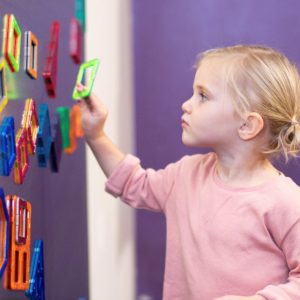STEAM Q & A with Dena Milliron, Curator of Education for the i.d.e.a. Museum
“STEAM activities are the foundation for early learning, they encourage problem solving and critical thinking. In the early years, this looks like playing. But kids are learning to ask questions and try new things. For example, playing with shadows can be an introduction to science when you encourage your child to make predictions about shadows as the light source moves. With block play, you are introducing engineering and design. How tall can this structure go? How much weight can it take?”
“Parents can help them learn by asking questions and giving them age-appropriate challenges. Plus, research shows when children are exposed – for example – to engineering concepts early in life, they become more aware of engineering, science, and technical careers. That’s a good thing for our children’s future in our economy.”
How do you incorporate STEAM concepts in your museum?
“i.d.e.a. Museum stands for imagination, design, experience, art. We’re always looking for ways to trigger the imagination and stimulate creativity throughout our exhibits and programs.
“When developing exhibitions, we discuss a variety of learning opportunities for various ages and abilities. We want caregivers and their children to come away with an age-appropriate learning experience that helps them view their world differently.
“We also now offer STEAM encounters via our virtual programs. We have two virtual school tours – one aimed at preschoolers and the other for elementary students – as well as Girl Scout badge workshops. Plus, we offer activity kits that support early learning (Skill Builders rolls out in February) and nurture creativity at home (HUB Activity Kit available online).”
What types of STEAM activities does the museum provide to children?
Children can enjoy shadow play in ArtVille, building with Magformers in the HUB and an Upcycle Challenge where visitors are given a variety of art materials and are asked to design/create something specific like tools, bridges, rocket ships, treehouses or instruments.
“We’ve also posted on our website a variety of Skill Builders, art and interactive activities you can do with your kids at home. We have about 100 options for you.”
How do these activities help?
“Vygotsky’s constructivist learning theory states that humans generate knowledge and meaning from an interaction between their experiences and their ideas. Children construct their own understanding and knowledge of the world by experiencing things and reflecting on those experiences. Children are active creators of their own knowledge, and by doing so, must ask questions, explore, and assess what they know.
“Engineering activities – for example – allow young children to develop skills such as problem solving, collaboration, communication and creativity that will be integral to their lives as they grow and develop. When engaging in activities that integrate engineering principles, children are encouraged to ask questions, think in broader terms, and inquire about the world around them. These experiences will inspire them to be critical thinkers and innovators. These skills provide a framework for the knowledge children will need to succeed in workforce and in life.”
Some STEAM activities in ArtVille and HUB:
- Science – Experimenting with shadows in ArtVille.
- Technology – Animation Station for creating video; Tech Table features spelling and puzzle play.
- Engineering – Magformers for building with magnets, plus Upcycle challenge in HUB.
- Art – Oodles of Doodles and Upcycle Challenge in HUB; Color Your World in ArtVille
- Math – Tangrams (geometry) in ArtVille.
Learn more about the museum visit: ideamuseum.org
Yvette Armendariz is a former award-winning business journalist and mom to two young adults. She is currently marketing director for the i.d.e.a. Museum.






